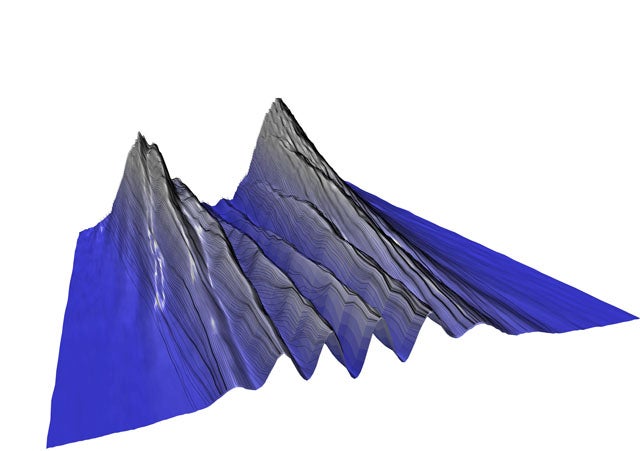An innovative approach to the famous double-slit experiment yields a new picture of the world at the quantum scale.

The researchers, including IQC postdoctoral fellow Krister Shalm, describe in the latest issue of Science how they succeeded in mapping the paths of photons (quantum particles of light) without actually disrupting those photons through direct observation.
To achieve their result, the researchers started with one of the most iconic experiments in physics — the famous double-slit experiment, known for nearly a century as an elegant demonstration of quantum mechanical effects. When a beam of light is shone through a pair of thin slits, the photons imprint a screen on the other side with a distinctive interference pattern. The original experiment, and the debates between Niels Bohr and Albert Einstein that ensued in 1927, seemed to establish that you could not watch a particle go through one of two slits without destroying the interference effect: you had to choose which phenomenon to look for.
But in their recent experiment at the University of Toronto, the researchers succeeded in experimentally depicting, for the first time, the trajectories the photons travelled through the experiment to form the interference pattern.
"With recent advances in technology we have gained the ability to control and manipulate the quantum world in exquisite detail," said Shalm, a co-author of the paper, titled "Observing the Average Trajectories of Single Photons in a Two-Slit Interferometer". We can now study quantum systems in ways that were previously thought to be impossible."
To measure the trajectories of photons, the researchers built upon new advances in "weak measurement" developed by Yakir Aharonov's group at Tel Aviv University. Howard Wiseman of Griffith University proposed that it might be possible to measure the direction a photon was moving, conditioned upon where the photon is found. By combining information about the photon's direction at many different points, Wiseman suggested one could construct its entire flow pattern (that is, trace the trajectories the photons travel toward the screen).
Using a new single-photon source developed at the National Institute for Standards and Technology in Colorado, the team sent photons one by one into a two-slit interferometer constructed at the University of Toronto. The researchers then used a quartz calcite, which has an effect on light that depends on the direction the light is propagating, to measure the direction as a function of position. This resulted in a kind of roadmap showing the paths that photons travelled, consistent with theoretical predictions.
The original double-slit experiment played a central role in the early development of quantum mechanics, leading directly to Bohr's theory that observing particle-like or wave-like behaviour in the double-slit experiment depends on the type of measurement made — the system cannot behave as both a particle and wave simultaneously. The new paper published in Science suggests this doesn't have to be the case: the system can behave as both.
By applying the "weak measurement" techniques to the historic double-slit experiment, they observed the average particle trajectories undergoing wave-like interference — the first observation of its kind.
"This opens up the opportunity to develop new technologies based on quantum mechanics, such as quantum cryptography and computing, that can solve problems out of the reach of classical physics," said Shalm, who co-authored the paper with lead investigator Aephraim Steinberg, Sacha Kocsis, Boris Braverman, Sylvain Ravets, Martin Stevens and Rich Mirin.
The experiment was a beautiful new method for approaching one of the most fundamental concepts in quantum mechanics, Steinberg concluded: "We are all just thrilled to be able to see, in some sense, what a photon does at it goes through an interferometer — something all of our textbooks and professors had told us was impossible."
Other coverage
Nature: "A Quantum Take on Certainty"
Science: "Quantum Mechanics Gets Weirdly Less Weird"
Waterloo Region Record: "Shaking the Box in Quantum Mechanics"
Research partners include the University of Toronto's Centre for Quantum Information and Quantum Control, Department of Physics and Institute for Optical Sciences, the National Institute of Standards and Technology in Boulder, Colorado, the Institute for Quantum Computing at the University of Waterloo, Griffith University, Australia, and the Laboratoire Charles Fabry in Orsay, France. Research was funded by the Natural Sciences and Engineering Research Council of Canada, the Canadian Institute for Advanced Research, and QuantumWorks.